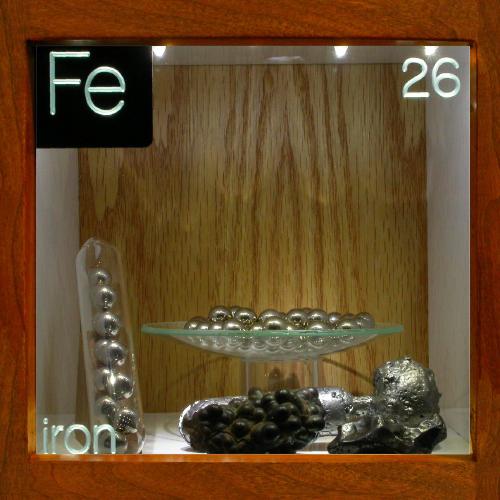Home Size: 1 2 3 4 5 6 7 8 9
|
 |
| Pure iron is a fairly soft, silvery metal that readily rusts in damp air. It is the commonest element in the earth, forming the molten core.
|
|
|
 |
Ball bearings.
These attractive steel ball bearings are sold as ammunition for a slingshot and could no doubt be deadly. As most people know, steel is basically iron with a small proportion of carbon. What fewer people know, is that steel actually contains LESS carbon than the raw cast iron from which it is made. So these steel balls are rather a pure sample of iron.
Source: Hunting supplier
Size: 3/8"
Purity: 99%
|
|
 |
Ball bearings ampouled under argon.
We were a bit concerned that the steel ball bearings on the open watch glass may eventually start to rust in the occasionally humid Indiana climate. Then we realized that this will be a great demonstration of one iron's key (unwelcome) properties. So we have ampouled this separate sample of steel balls under argon for comparison. Apart from anything else, they spontaneously form this pleasing zig zag arrangement.
Source: Hunting supplier
Size: 3/8"
Purity: 99%
|
|
 |
Thermite casting.
One of the great wonders of chemistry is the thermite reaction which you can witness if you watch the accompanying video. This is the result: a solid slug of reasonably pure iron. It is a little cooler now than when it flowed in a white hot molten stream out of the reaction chamber into a graphite mould.
Source: Beach sand and paint store
Size: 4"
Purity: >95%
|
|
 |
Meteorite.
This is a meteorite from the Sikhote-Alin meteor shower which fell at 10.38am local time on February 12th 1947 in Sikhote-Alin, Maritime Province in the Russian Far East. The meteorite had an estimated mass of around 100 tons and entered Earth's atmosphere at more than 28,000 miles per hour. It broke up on entering the atmosphere, with the fragments falling together, enduring further break-ups of the larger pieces as they descended. The pieces from the first break up are deeply ablated and have a fusion crust, those from the second fragmentation also exhibit ablation (melted areas, almost like thumb prints), whilst those from the third fragmentation exhibit much less melting (mainly a softening and smoothing of the sharp broken edges) and those from the fourth and final fragmentation didn't have time to melt before hitting the ground and have sharp edges. The fall left approximately 120 craters and could be seen and heard for some 200 miles around the impact point. The meteorite is composed of 92.94% iron, 5.90% nickel, 0.42% cobalt, 0.46% phosphorus, 0.28% sulfur and trace amounts of copper, gallium, germanium and iridium.
Source: Mackay mineral collection
Size: 1"
Purity: 92.94%
|
|
 |
Hematite.
Hematite takes its name from the Greek haimatites (blood-like), referring to its color which ranges from reddish gray through blackish red to black, although anyone with blood that color would be well advised to consult a doctor. Its other name, kidney ore, refers to its reniform (kidney-like) habit, as seen in this specimen. Hematite can also occur as exquisite rosettes of black metallic tabular crystals known as hematite or iron roses. It is one of the principal ores of iron.
Source: Mackay mineral collection
Size: 1.25"
Purity: 70%
|
|
|

